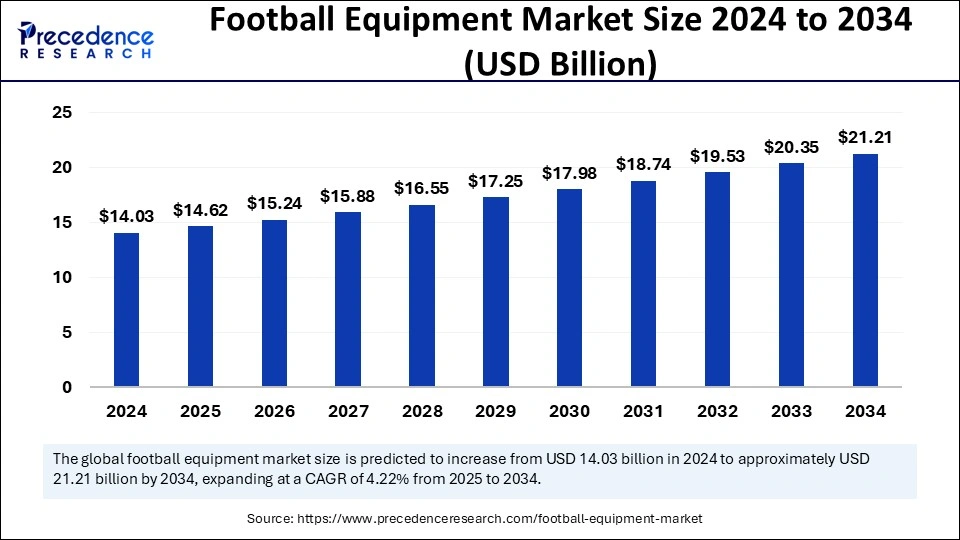Football equipment market size to expand from USD 14.03 billion in 2024 to USD 21.21 billion by 2034, growing at a steady CAGR of 4.22%.

Football Equipment Market Key Takeaways
-
In 2024, North America led the global market with a 36% share.
-
Europe is anticipated to experience the fastest growth in the upcoming years.
-
The football segment dominated the market by product type in 2024.
-
The footwear segment is projected to record the highest CAGR between 2025 and 2034.
-
Leather was the leading material segment by market share in 2024.
-
The synthetic material segment is expected to see significant growth throughout the forecast period.
-
The offline distribution channel accounted for the largest share of the market in 2024.
-
The online distribution channel is projected to expand at the highest CAGR from 2025 to 2034.
-
Among end-users, professional players held the top market share in 2024.
-
The youth players segment is forecasted to grow at a notable CAGR over the projection period.
Football Equipment Market Overview
The Football Equipment Market has evolved significantly with the introduction of cutting-edge technologies that enhance player performance, durability, and comfort. As football remains the most popular sport globally, there is a rising demand for high-performance gear that meets the needs of both professional and amateur players.
Equipment manufacturers are focusing on smart fabrics, AI-driven training accessories, and digital integration to improve the overall football experience. The market’s growth is further supported by an increasing number of football academies, rising fan engagement, and the expansion of professional leagues into new territories.
Football Equipment Market Drivers
Technological advancements in football equipment design are a major driver of market growth. The use of lightweight synthetic materials in cleats, moisture-wicking fabrics in jerseys, and impact-resistant padding in shin guards has improved player safety and comfort. The influence of football stars on consumer behavior is another driving factor, as fans seek to replicate the gear worn by their favorite athletes.
Increased investments in football infrastructure, including stadium renovations and training facilities, contribute to the growing demand for high-quality equipment. The rise of digital platforms and e-commerce has also simplified access to premium football products, allowing brands to reach a global audience.
Football Equipment Market Opportunities
The introduction of AI-powered coaching tools and wearable technology presents a significant opportunity for market players.
Smart footballs embedded with tracking chips enable coaches and players to analyze performance metrics, making training sessions more data-driven. Customizable and personalized football gear, such as 3D-printed shin guards and custom-fitted cleats, is also gaining popularity.
The trend toward sustainability is creating opportunities for brands to develop biodegradable football boots and environmentally friendly sportswear, catering to the eco-conscious consumer.
Football Equipment Market Challenges
The Football Equipment Market faces challenges related to counterfeit products that threaten brand reputation and consumer trust. Regulatory compliance regarding safety standards for protective gear also adds to production complexities.
Another major challenge is the fluctuating cost of raw materials, which affects pricing strategies for manufacturers. Additionally, the market is highly competitive, requiring brands to constantly innovate and differentiate their products to maintain a strong market position.
Football Equipment Market Regional Insights
The European market remains dominant, benefiting from a well-established football culture and high consumer spending on sports merchandise.
North America is witnessing increased engagement due to the growing popularity of Major League Soccer and youth soccer programs.
The Asia-Pacific region, particularly China and India, is experiencing a football boom, with government initiatives and rising interest among younger generations driving demand.
Latin America continues to be a passionate football hub, with a steady demand for high-quality equipment.
Africa is an emerging market with a focus on grassroots development and improved football infrastructure.
Football Equipment Market Recent Developments
Recent trends in football equipment include smart jerseys with built-in biometric sensors, allowing players to monitor their physical performance in real time. Leading brands have introduced modular football boots with interchangeable soleplates, catering to different playing conditions.
The industry has also seen collaborations between sportswear companies and sustainability organizations to create carbon-neutral football gear. Online customization tools that enable players to design their jerseys and boots have gained popularity, enhancing consumer engagement and brand loyalty.
Football Equipment Market Companies
- Under Armour
- Joma
- New Balance
- Kelme
- Kappa
- Adidas
- Nike
- Umbro
- Lotto
- Mizuno
- Diadora
- Hummel
- Grand Sport
- Puma
- Asics
Segments Covered in the Report
By Product Type
- Football
- Footwear
- Protective Gear
- Training Equipment
- Accessories
By Material
By Distribution Channel
- Online
- Offline
- Sports Stores
- Wholesale
By End-user
- Professional Players
- Amateur Players
- Youth Players
- Coaches
- Clubs
By Region
- North America
- Europe
- Asia Pacific
- Latin America
- Middle East and Africa
Ready for more? Dive into the full experience on our website!